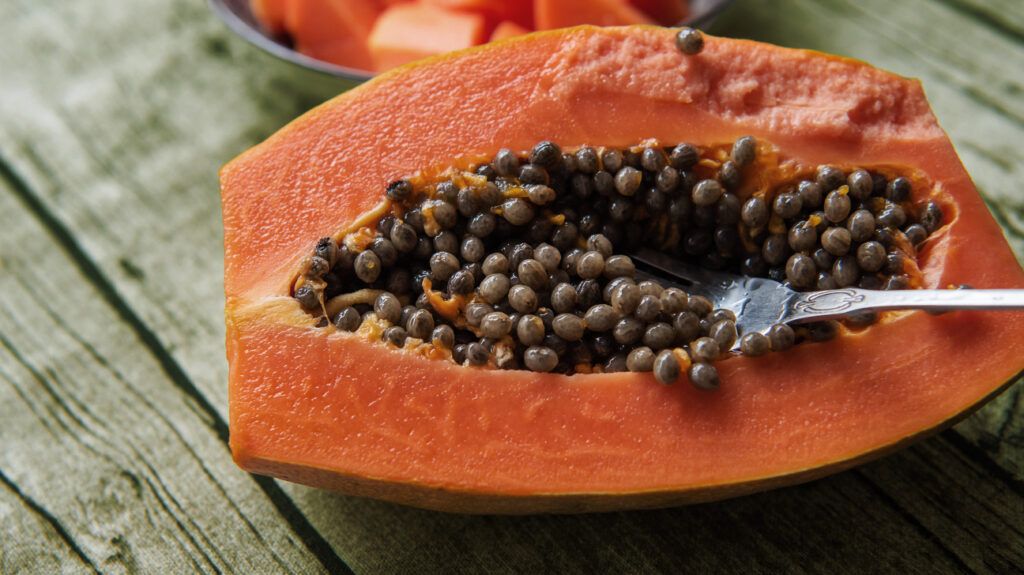Papayas contain a range of nutrients, such as antioxidants and potassium. Possible health benefits of eating papaya may include reducing the risk of heart disease, diabetes, cancer, and more.
Papaya, papaw, or pawpaw, is a soft, fleshy fruit of the plant species Carica papaya.
This article examines the possible health benefits and uses of papaya fruit, its nutritional value, and how to incorporate more papaya into a diet.
Fast facts on papaya:
- Papaya is native to Mexico. However, it grows naturally in the Caribbean and Florida too.
- According to the Food and Agriculture Organization of the United Nations (FAO), India produces the most papayas – over 5 million tons in 2013.
- It can be added to salads, smoothies, and other dishes.

The nutrients in papaya may have a range of health benefits. They may help protect against a number of health conditions.
Vision and eye health
Some of the organic compounds present in papaya
One of these compounds, called lycopene, may help protect the retinal pigment epithelium — a part of the retina essential for healthy vision — against inflammation and oxidative stress.
Papaya also contains carotene, a compound that gives the papaya its distinctive orange color. Carotene has links to vision improvement and the prevention of night blindness.
Zeaxanthin, an antioxidant in papaya, filters out harmful blue light rays. It is thought to play a protective role in eye health and may ward off macular degeneration.
Asthma
Consuming a high amount of fruits and vegetables
This may be due to dietary components in fruits and vegetables, such as antioxidants, fiber, and vitamin D. These nutrients can assist the immune system’s typical functioning, which over-responds in people with asthma.
One
A
Cancer
Many of the compounds present in papaya — such as lycopene, zeaxanthin, and lutein,
A
A
Another
Additionally, eating a diet rich in fruits and vegetables can help
Bone health
Papaya is a source of vitamin K. Low intakes of vitamin K have
Adequate vitamin K consumption is important for good health. It improves calcium absorption and may reduce urinary excretion of calcium, meaning there is more calcium in the body to strengthen and rebuild bones.
Diabetes
Studies have shown that people with type 1 diabetes who consume high fiber diets have lower blood glucose levels. Additionally, those with type 2 diabetes following high fiber diets may have improved blood sugar, lipid, and insulin levels.
One small papaya provides
Digestion
Papaya is high in fiber and water content, which help prevent constipation and promote regularity and a healthy digestive tract.
Heart disease
Antioxidants in papaya, such as lycopene,
It is also high in potassium, which can be beneficial for those with high blood pressure.
An increase in potassium intake along with a decrease in sodium intake is the most important dietary change someone can make to reduce their risk of cardiovascular disease.
Hair health
Papaya is also great for hair because it contains vitamin A, a nutrient necessary for sebum production, which keeps hair moisturized.
Vitamin A is also necessary for the growth of all bodily tissues, including skin and hair.
Adequate intake of vitamin C, which papaya can provide, is necessary for the building and maintenance of collagen, which provides structure to the skin.
Papayas are a high source of vitamin C. One small fruit provides about
One medium papaya has approximately:
- 120 calories
- 30 g of carbohydrate — including 5 g of fiber and 18 g of sugar
- 2 g of protein
Papayas are also a suitable source of:
They also have B vitamins, alpha and beta-carotene, lutein and zeaxanthin, vitamin E, calcium, potassium, vitamin K, and lycopene, the powerful antioxidant most commonly associated with tomatoes.
There are many simple ways to add papaya to a diet. A person can eat papaya on its own, and it has a sweet, buttery interior. The following section provides tips for preparing and eating papaya.
How to eat papaya
When choosing or eating papaya, it is best to look for fresh papayas with soft, reddish-orange skins.
A person can simply cut it in half, scoop out the seeds, and enjoy. The seeds of the papaya are edible but have a bitter, peppery taste. Using a spoon, it is possible to scoop out the soft flesh of the fruit.
Papaya is a soft, versatile fruit, meaning a person can incorporate it into many recipes. A person can consider the following simple methods of preparation:
- Make a tropical fruit salad with fresh papaya, pineapple, and mango.
- Muddle papaya into a glass of lemonade, iced tea, or water for a burst of fresh, fruity flavor.
- Make a fresh salsa with papaya, mango, jalapeno, red peppers, and chipotle pepper. Use as a topping for fish tacos.
- Add a few slices of frozen papaya to smoothies. Combine with pineapple juice, half a frozen banana, and Greek yogurt for a sweet tropical treat.
Papaya fruit is a common food and is safe to eat when ripe.
However, unripe papaya papaya contains papaya latex, which contains an enzyme called papain. Taking large amounts of this enzyme could damage the esophagus, but this risk is low when consuming ripe papaya.
Additionally, people with a latex allergy may also be allergic to papaya, so they may need to exercise caution around the fruit and products containing papaya.
Papaya is a sweet, fleshy fruit native to Mexico. People can eat its pinkish-orange soft flesh on its own or add it to salads, smoothies, or other dishes.
It is high in nutrients such as vitamin C, folate, vitamin A, magnesium, fiber, and antioxidants.
Some of the possible benefits of papaya include anticancer effects, anti-inflammatory properties, and more. Papaya can benefit cardiovascular health, vision and eye health, hair and bone health, and more.
